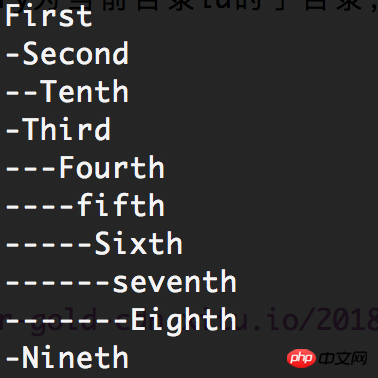Home > Article > Backend Development > Unlimited classification and infinite nested comments in PHP
This article mainly introduces the infinite classification and infinite nested comments in PHP. It has a certain reference value. Now I share it with you. Friends in need can refer to it
In the previous article, we talked about recursion, the basis of actual PHP data structure. Let’s review what is recursion?
Generally speaking, recursion is called a call to the function itself.
Infinite-level classification is a common requirement in normal development, and it is included in many interview questions bump into. No matter what project you do, you should have encountered similar problems. Next, we will use the idea of recursion to practice.
SQL structure
CREATE TABLE `categories` ( `id` int(11) NOT NULL AUTO_INCREMENT, `categoryName` varchar(100) NOT NULL, `parentCategory` int(11) DEFAULT '0', `sortInd` int(11) NOT NULL, PRIMARY KEY (`id`) ) ENGINE=InnoDB AUTO_INCREMENT=11 DEFAULT CHARSET=utf8;
Then we virtualize some data, and it finally looks like this.

Let’s look directly at the code implementation.
query($sql, PDO::FETCH_OBJ);
$categories = [];
foreach ($result as $category) {
$categories[$category->parentCategory][] = $category;
}
function showCategoryTree($categories, $n)
{
if (isset($categories[$n])) {
foreach ($categories[$n] as $category) {
echo str_repeat('-', $n) . $category->categoryName . PHP_EOL;
showCategoryTree($categories, $category->id);
}
}
return;
}
showCategoryTree($categories, 0);
As you can see, we first obtained all the data, and then classified it according to the parent ID. This is a great data structure. Imagine that we decompose the problem of displaying all subdirectories under the top-level directory into displaying its own category title and displaying the subdirectory whose parentCategory is the current directory id in the data, and then using to start the recursive call. The final output looks like this.

Let’s first look at what infinitely nested comments look like. As shown in the picture:

#The chestnut above is another classic case that can be solved using recursion. Let’s take a look at the data structure.
CREATE TABLE `comments` ( `id` int(11) NOT NULL AUTO_INCREMENT, `comment` varchar(500) NOT NULL, `username` varchar(50) NOT NULL, `datetime` datetime NOT NULL, `parentID` int(11) NOT NULL, `postID` int(11) NOT NULL, PRIMARY KEY (`id`) ) ENGINE=InnoDB AUTO_INCREMENT=11 DEFAULT CHARSET=latin1;
You can practice it yourself without reading the following content.
prepare($sql);
$stmt->setFetchMode(PDO::FETCH_OBJ);
$stmt->execute([':id' => 1]);
$result = $stmt->fetchAll();
$comments = [];
foreach ($result as $comment) {
$comments[$comment->parentID][] = $comment;
}
function showComments(array $comments, $n)
{
if (isset($comments[$n])) {
foreach ($comments[$n] as $comment) {
echo str_repeat('-', $n) . $comment->comment . PHP_EOL;
showComments($comments, $comment->id);
}
}
return;
}
showComments($comments, 0);
An example of using recursion to scan directory files.
$value) {
$path = realpath($dir . DIRECTORY_SEPARATOR . $value);
if (!is_dir($path)) {
$allFiles[] = $path;
} else if ($value != "." && $value != "..") {
showFiles($path, $allFiles);
$allFiles[] = $path;
}
}
return;
}
$files = [];
showFiles('.', $files);
foreach ($files as $file) {
echo $file . PHP_EOL;
}
The above is the entire content of this article. I hope it will be helpful to everyone's study. For more related content, please pay attention to the PHP Chinese website!
Related recommendations:
Recursion based on PHP data structure
The above is the detailed content of Unlimited classification and infinite nested comments in PHP. For more information, please follow other related articles on the PHP Chinese website!